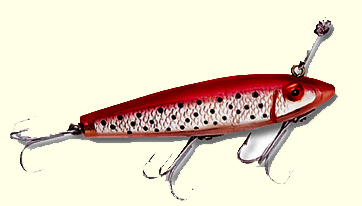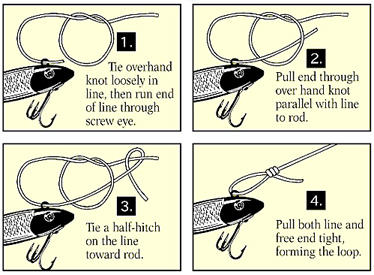Tying knots began before the dawn of history when man tied a stone to a stick. Through the years knots have been associated with primitive religion, folklore, magic, and superstitions. Tying knots have numerous of uses and a biological study found that man is not the only species to use knots. Gorillas use them to hold saplings down in their nests. In one nest two dozen knots were counted, most were granny knots but some were square knots. There is a particular species of bird that ties knots in the construction of its nest. And there are still primitive races that fasten their huts, traps and even clothing with knots.
With the hundreds of knots available today anglers put too much emphasis on knowing how to tie every one. In fact when it comes to fishing whether it s fresh or saltwater, inshore or offshore the average angler only needs to master four or five knots relating directly to their methods of fishing. Learning to effectively tie a few simple knots enables you to catch whatever species you re targeting. For example, on inshore charters I only use five knots, a Uni Knot, Double-Uni Knot, Triple Surgeons, Loop Knot and the occasional Spider Hitch.
After you ve chosen the knots for your particular application and regardless which knot you prefer, tying it correctly is essential for achieving fish catching success. A large proportion of losses can be blamed on poorly tied knots. Therefore, it s essential that you spend an extra second or two to insure your knots are tied properly. By using the elements listed below your knots should retain their breaking strength.
- Practice, Practice, Practice... Take a length of fishing line, a hook with the point cut off, and practice until you can tie each knot correctly 25 times.
- Always lubricate your knots with saliva as you pull them tight. This prevents damage to the line and allows the knot to pull tight.
- Trim knots closely. A good knot, pulled tight, will not come loose. Close trimming prevents the knot from catching snags or weeds.
- When you're learning knots, the "tag end" sometimes called the working end is the end of the line used to tie the knot. The "standing end" is that part of the line coming from your fishing reel.
- Always leave plenty of the tag end for tying knots so that you can tie them properly.
- Pull up all ends when tightening the knot cinching them as tight as possible. If it slips in your hand, it will slip when you re hooked up
- Once you find a knot that's working for your particular type of fishing don't forget it.
Originally designed to keep hooks attached to fishing line knots soon took on another aspect with the onset of artificial lures. They became more than just means of keeping a hook or lure on the line. They actually made a difference in how baits and lures performed. Fishing fresh or saltwater, with artificial lures your are trying to immolate the actions of a natural food source; so stands to reason that everything we can do to add realistic actions should help us catch fish.
There are many excellent knots in use today, especially when t here is a need to catch fish but one stands out as an intelligent choice. It provides artificial lures and natural baits the most realistic approach and appeal and it s called a Loop Knot.
Actually loop knots have been use for decades but now with swim baits, top waters, diving and suspending lures along with a variety of soft plastics this knot has emerged as the go-to method of attaching lures to your fishing line.
When properly tied loop knots give lures and natural baits an element of free swimming action. An action you otherwise loose when using knots that secure your lure or hook directly to the line. Because it s imperative to imitate a natural and lively food source this is an important knot and one you should learn to tie and use.
Perfecting the skill of proper casting and retrieve takes plenty of practice and sometimes years to master however, something as simple as a knot can have a discernible result on your overall success. With so many knots in use today often the slightest difference makes your bait seem more lively or natural this subtle little different often triggers the strike you ve waited for all day.
For charter information or to book trips call Captain Woody Gore at:
Cell: 813-477-3814
Office 813-982-2034
Email: WGORE@IX.NETCOM.COM
Website: WWW.CAPTAINWOODYGORE.COM




